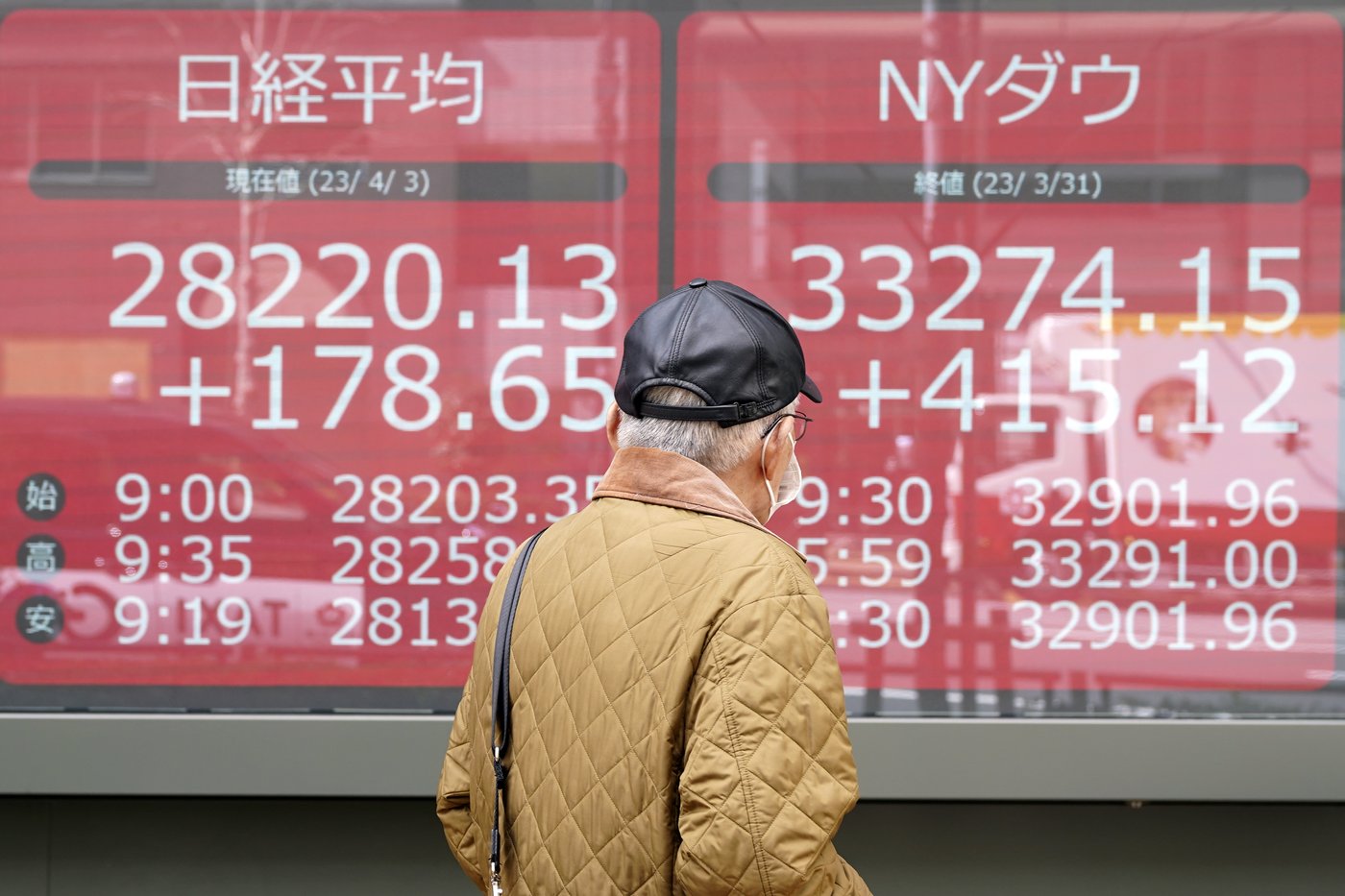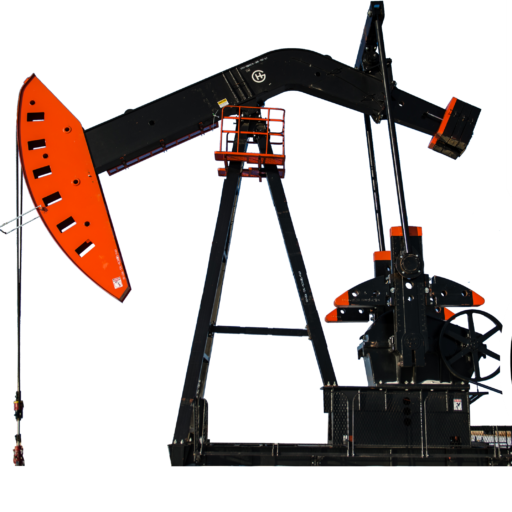Associate Press copy is provided via The Canadian Press

A person walks in front of an electronic stock board showing Japan’s Nikkei 225 and New York Dow indexes at a securities firm Monday, April 3, 2023, in Tokyo. Oil prices soared more than 5% after Saudi Arabia and other major oil producers said they will cut production by 1.15 million barrels per day from May until the end of the year. Shares in Asia were mixed on Monday and the dollar rose against the Japanese yen. (AP Photo/Eugene Hoshiko)
by Elaine Kurtenbach in Bangkok
BANGKOK (AP) — Oil prices soared nearly 6% on Monday after Saudi Arabia and other major oil producers said they will cut production by 1.15 million barrels per day from May until the end of the year. Shares in Asia were mixed.
U.S. benchmark crude oil rose $4.24 to $79.91 per barrel, or 5.6%, in electronic trading on the New York Mercantile Exchange. It rose $1.30 to $75.67 per barrel on Friday, ahead of the weekend meeting where members of the so-called OPEC+ group of oil exporting countries decided on the cuts, which are in addition to a reduction announced last October that infuriated the Biden administration.
Brent crude, the pricing basis for international oils, gained $4.35 to $84.24 per barrel, or 5.4%.
The cuts in oil output immediately pushed prices higher and were expected to boost gas prices, adding to strains in many countries where high fuel prices are a heavy burden. Higher oil prices also will complicate the efforts by central banks to rein in inflation.
“This will create both political waves across Europe and even higher general inflation in the USA, leading to renewed pressure on the Federal Reserve to keep hiking rates aggressively,” Clifford Bennett, chief economist at ACY Securities, said in a report.
European shares opened higher. Germany’s DAX added 0.2% to 15,665.63 and the CAC40 in Paris climbed 0.5% to 7,356.77. Britain’s FTSE 100 surged 0.8% to 7,694.79.
The future for the S&P 500 slipped 0.2% while the contract for the Dow Jones Industrial Average gained 0.3%.
In Asian trading, Tokyo’s Nikkei 225 index gained 0.5% to 28,188.15, even after a quarterly survey by the Bank of Japan showed business sentiment among big Japanese manufacturers falling in the first quarter of this year. The headline measure of the “Tankan” showed positive sentiment falling to 1 from 7 in December, the worse quarterly result since since December 2020.
Hong Kong’s Hang Seng edged 9 points higher to 20,409.18, while the Shanghai Composite index rose 0.7% to 3,296.40. In South Korea, the Kospi fell 0.2% to 2,472.34.
Australia’s S&P/ASX 200 advanced 0.6% to 7,223.00. Shares rose in Taiwan but edged lower in Bangkok.
Surveys of purchasing managers in emerging Asian markets declined last month as export orders weakened, adding to signs of fragility in the global economy.
“With global growth set to remain weak in the coming quarters, we expect manufacturing output in Asia to remain under pressure,” Shivaan Tandon of Capital Economics said in a commentary.
On Friday, the S&P 500 gained 1.4% Friday, rising 3.5% for the month, with tech stocks leading the way. Friday’s gains came after a report showed inflation slowed in February, though it was still high on a historical basis. A slowdown in inflation could give the Federal Reserve more leeway to take it easier on interest rates.
The Dow Jones Industrial Average rose 1.3%, while the Nasdaq composite climbed 1.7%. Big leaps for technology stocks drove a Nasdaq gain of 16.8% for the quarter.
High rates can undercut inflation but only by bluntly slowing the entire economy, which raises the risk of a recession. They also drag down prices for stocks, bonds and other investments.
Expectations for an easier Fed have helped Big Tech stocks in particular because high-growth stocks are seen as some of the biggest beneficiaries of lower rates. That’s helped to prop up the S&P 500, where Big Tech stocks play an outsized role because of their massive size. Apple, Microsoft and Google’s parent Alphabet each posted double-digit gains for March.
Adding to challenges for the Fed, the second- and third-largest U.S. bank failures in history rocked markets after depositors rushed to pull their money out of Silicon Valley Bank and Signature Bank. The runs have pushed investors to cast harsher scrutiny on banks globally in the hunt for seemingly weak links.
The banking industry’s troubles also could act like hikes to interest rates if they cause banks to pull back on lending, stifling hiring and growth for the economy.
In other trading Monday, the U.S. dollar rose to 133.50 Japanese yen from 133.28 yen late Friday. The euro strengthened to $1.0848 from $1.0844.
- 0100 Turnbull Project Manager0100 Turnbull Project Manager
- 0099 Mryglod Steel 1080p0099 Mryglod Steel 1080p
- 0097 Eagle Sky Ventures LTD0097 Eagle Sky Ventures LTD
- 0095 Fast Trucking nearly 70 years good at it0095 Fast Trucking nearly 70 years good at it
- 0053 Kingston Midstream Westspur Alameda Click Before You Dig0053 Kingston Midstream Westspur Alameda Click Before You Dig
- 0092 Turnbull projects big and small0092 Turnbull projects big and small
- 0046 City of Estevan This is Estevan Teaser0046 City of Estevan This is Estevan Teaser
- 0087 Lori Carr Coal Expansion0087 Lori Carr Coal Expansion
- 0077 Caprice Resources Stand Up For Free Speech0077 Caprice Resources Stand Up For Free Speech
- 0076 Latus only0076 Latus only
- 0061 SIMSA 2024 For Sask Buy Sask0061 SIMSA 2024 For Sask Buy Sask
- 0055 Smart Power Be Smart with your Power office0055 Smart Power Be Smart with your Power office
- 0051 JML Hiring Pumpjack assembly0051 JML Hiring Pumpjack assembly
- 0049 Scotsburn Dental soft guitar0049 Scotsburn Dental soft guitar
- 0041 DEEP Since 2018 now we are going to build0041 DEEP Since 2018 now we are going to build
- 0032 IWS Summer hiring rock trailer music
- 0022 Grimes winter hiring
- 0021 OSY Rentals S8 Promo
- 0018 IWS Hiring Royal Summer
- 0013 Panther Drilling PO ad 03 top drive rigs
- 0006 JK Junior
- 0002 gilliss casing services0002 gilliss casing services
- 9002 Pipeline Online 30 sec EBEX9002 Pipeline Online 30 sec EBEX
- 9001
